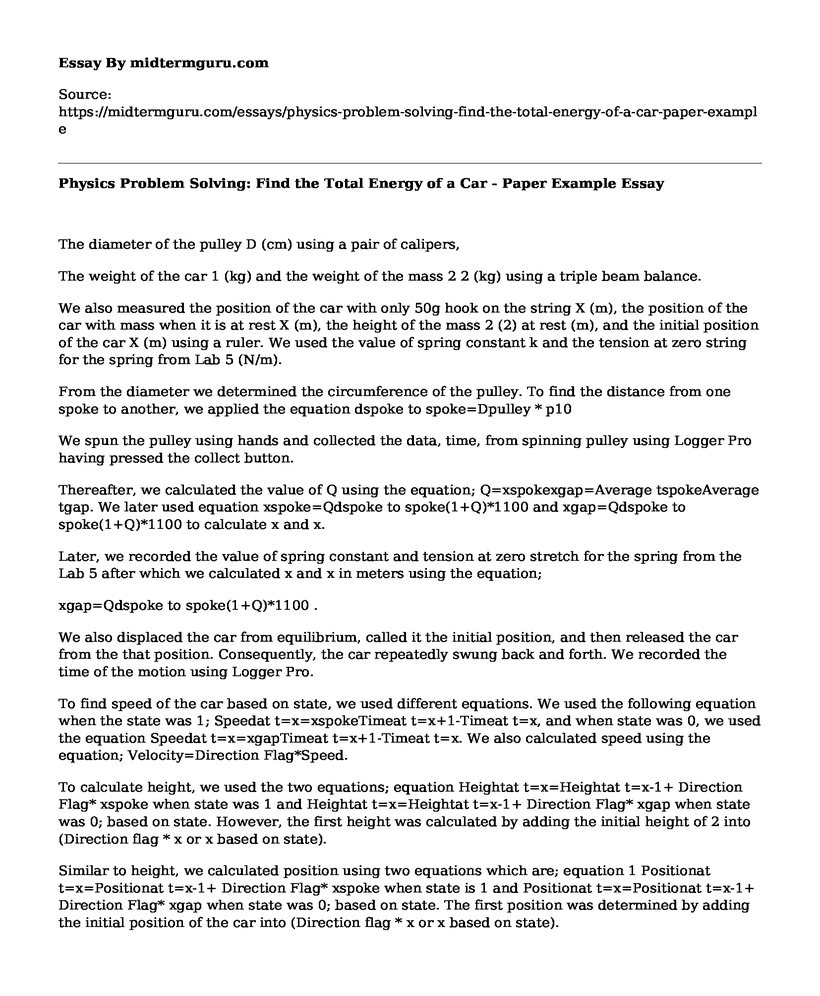The diameter of the pulley D (cm) using a pair of calipers,
The weight of the car 1 (kg) and the weight of the mass 2 2 (kg) using a triple beam balance.
We also measured the position of the car with only 50g hook on the string X (m), the position of the car with mass when it is at rest X (m), the height of the mass 2 (2) at rest (m), and the initial position of the car X (m) using a ruler. We used the value of spring constant k and the tension at zero string for the spring from Lab 5 (N/m).
From the diameter we determined the circumference of the pulley. To find the distance from one spoke to another, we applied the equation dspoke to spoke=Dpulley * p10
We spun the pulley using hands and collected the data, time, from spinning pulley using Logger Pro having pressed the collect button.
Thereafter, we calculated the value of Q using the equation; Q=xspokexgap=Average tspokeAverage tgap. We later used equation xspoke=Qdspoke to spoke(1+Q)*1100 and xgap=Qdspoke to spoke(1+Q)*1100 to calculate x and x.
Later, we recorded the value of spring constant and tension at zero stretch for the spring from the Lab 5 after which we calculated x and x in meters using the equation;
xgap=Qdspoke to spoke(1+Q)*1100 .
We also displaced the car from equilibrium, called it the initial position, and then released the car from the that position. Consequently, the car repeatedly swung back and forth. We recorded the time of the motion using Logger Pro.
To find speed of the car based on state, we used different equations. We used the following equation when the state was 1; Speedat t=x=xspokeTimeat t=x+1-Timeat t=x, and when state was 0, we used the equation Speedat t=x=xgapTimeat t=x+1-Timeat t=x. We also calculated speed using the equation; Velocity=Direction Flag*Speed.
To calculate height, we used the two equations; equation Heightat t=x=Heightat t=x-1+ Direction Flag* xspoke when state was 1 and Heightat t=x=Heightat t=x-1+ Direction Flag* xgap when state was 0; based on state. However, the first height was calculated by adding the initial height of 2 into (Direction flag * x or x based on state).
Similar to height, we calculated position using two equations which are; equation 1 Positionat t=x=Positionat t=x-1+ Direction Flag* xspoke when state is 1 and Positionat t=x=Positionat t=x-1+ Direction Flag* xgap when state was 0; based on state. The first position was determined by adding the initial position of the car into (Direction flag * x or x based on state).
We used equation GPEat t=x=m2+ gravity+Heightat t=x, to find Gravitational Potential Energy (GPE). For stretch of the spring, we used equation Stretchat t=x=Positionat t=x-Equilibrium Position. The formula for The Spring Potential Energy (SPE) was 12kx2+Tensionstretch=0*x. The value of stretch was used for x in this case because the Spring Potential Energy depends on stretch. Thus, we calculated the Spring Potential Energy (SPE) calculated by equation 12Spring Constant k*(Stretchat t=x)2+Tensionstretch=0*Stretchat t=x.
We also determined the Kinetic Energy (KE) by equation 12mv2. We used both mass 1 and mass 2 for the Kinetic Energy because they both have kinetic energy since they are moving and have the same velocity. Finally, we used equation TE = GPE + SPE + KE to find the Total Energy (TE).
Cite this page
Physics Problem Solving: Find the Total Energy of a Car - Paper Example. (2021, Jun 14). Retrieved from https://midtermguru.com/essays/physics-problem-solving-find-the-total-energy-of-a-car-paper-example
If you are the original author of this essay and no longer wish to have it published on the midtermguru.com website, please click below to request its removal:
- Membrane Ultrafiltration: Preliminary Treatment of Wastewater
- Paper Example on Fire Characteristics: Gaseous Combustibles
- Determining the Rate of Reaction for the Oxidation of Oxalic Acid by Permanganate
- Politics Essay Sample: Political Geography and Theoretical Models
- Relationship between CCA (Conventional Core Analysis) and SCAL (Special Core Analysis)
- Ferric Chloride as the Best Catalyst in Chlorobenzenes Production
- Paper Example on Physical Anthropology







